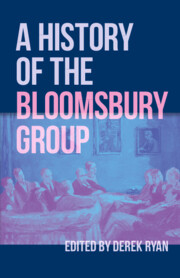Refine search
Actions for selected content:
420 results
Introduction
-
- Book:
- Nostalgia and National Identity in the British and Irish Modernist Epic
- Published online:
- 27 November 2025
- Print publication:
- 18 December 2025, pp 1-24
-
- Chapter
- Export citation
27 - Les Murray
-
-
- Book:
- The Cambridge History of Australian Poetry
- Published online:
- 19 November 2025
- Print publication:
- 11 December 2025, pp 508-522
-
- Chapter
- Export citation
Chapter 16 - The People’s War
- from Part IV - In the Name of the People
-
-
- Book:
- 'The People' and British Literature
- Published online:
- 11 December 2025
- Print publication:
- 11 December 2025, pp 257-272
-
- Chapter
- Export citation
14 - Kenneth Slessor’s Visualism
-
-
- Book:
- The Cambridge History of Australian Poetry
- Published online:
- 19 November 2025
- Print publication:
- 11 December 2025, pp 258-274
-
- Chapter
- Export citation
Chapter 9 - Experiments in Left Populism
- from Part II - The Revolutionary People
-
-
- Book:
- 'The People' and British Literature
- Published online:
- 11 December 2025
- Print publication:
- 11 December 2025, pp 141-156
-
- Chapter
- Export citation
13 - Fin-de-Siècle Symbolism and After
-
-
- Book:
- The Cambridge History of Australian Poetry
- Published online:
- 19 November 2025
- Print publication:
- 11 December 2025, pp 240-257
-
- Chapter
- Export citation
Chapter 3 - Print Fiction
-
- Book:
- American Narrative Realism
- Published online:
- 17 November 2025
- Print publication:
- 04 December 2025, pp 60-85
-
- Chapter
- Export citation
14 - Poetic Accumulation, Modernist Verse, and Imperial Capital
- from Part III - Figures, Movements, and Histories: 1900–1945
-
-
- Book:
- The Cambridge Companion to British Literature and Empire
- Published online:
- 20 November 2025
- Print publication:
- 04 December 2025, pp 202-215
-
- Chapter
- Export citation
16 - Joyce and His Contemporaries
- from Part III - Figures, Movements, and Histories: 1900–1945
-
-
- Book:
- The Cambridge Companion to British Literature and Empire
- Published online:
- 20 November 2025
- Print publication:
- 04 December 2025, pp 230-243
-
- Chapter
- Export citation
Chapter 1 - Redefining Realism
-
- Book:
- American Narrative Realism
- Published online:
- 17 November 2025
- Print publication:
- 04 December 2025, pp 5-32
-
- Chapter
- Export citation
13 - Unraveling Adventure Fictions
- from Part III - Figures, Movements, and Histories: 1900–1945
-
-
- Book:
- The Cambridge Companion to British Literature and Empire
- Published online:
- 20 November 2025
- Print publication:
- 04 December 2025, pp 189-201
-
- Chapter
- Export citation

Nostalgia and National Identity in the British and Irish Modernist Epic
-
- Published online:
- 27 November 2025
- Print publication:
- 18 December 2025
Introduction
-
- Book:
- American Modernism and the Cartographic Imagination
- Published online:
- 09 October 2025
- Print publication:
- 23 October 2025, pp 1-29
-
- Chapter
- Export citation
Chapter 5 - Post-Impressionism and the Bloomsbury Brand
- from Part I - Aesthetic Bloomsbury
-
-
- Book:
- A History of the Bloomsbury Group
- Published online:
- 09 October 2025
- Print publication:
- 23 October 2025, pp 68-85
-
- Chapter
- Export citation
Chapter 15 - Bloomsbury’s Gender Politics
- from Part III - Intimate Bloomsbury
-
-
- Book:
- A History of the Bloomsbury Group
- Published online:
- 09 October 2025
- Print publication:
- 23 October 2025, pp 242-258
-
- Chapter
- Export citation
Chapter 1 - Maps from Indigenous Territory
-
- Book:
- American Modernism and the Cartographic Imagination
- Published online:
- 09 October 2025
- Print publication:
- 23 October 2025, pp 30-67
-
- Chapter
- Export citation

A History of the Bloomsbury Group
-
- Published online:
- 09 October 2025
- Print publication:
- 23 October 2025
Chapter 1 - Life
-
- Book:
- The Cambridge Introduction to Ernest Hemingway
- Published online:
- 15 September 2025
- Print publication:
- 02 October 2025, pp 3-20
-
- Chapter
- Export citation
Chapter 2 - Contexts
-
- Book:
- The Cambridge Introduction to Ernest Hemingway
- Published online:
- 15 September 2025
- Print publication:
- 02 October 2025, pp 21-30
-
- Chapter
- Export citation
Chapter 3 - Crafting a Style
-
- Book:
- The Cambridge Introduction to Ernest Hemingway
- Published online:
- 15 September 2025
- Print publication:
- 02 October 2025, pp 31-63
-
- Chapter
- Export citation
